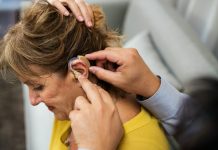
In a recent study at the University of Arizona, researchers found that treating patients with an advanced form of age-related macular degeneration (AMD) with levodopa, a safe and readily available drug to treat Parkinson’s disease, could stabilize and improve their vision.
It reduced the number of treatments necessary to maintain vision, and as such, will potentially reduce the burden of treating the disease, financially and otherwise.
The study is published in the American Journal of Medicine. One author is Robert W. Snyder, MD, Ph.D.
More than 15% of the US population over the age of 70 has AMD, a common cause of blindness in developed nations.
Neovascular AMD (nAMD) is characterized by the abnormal growth of new blood vessels, triggered by vascular endothelial growth factor (VEGF), which can cause fluid and blood to leak in the subretinal space of the eye.
The standard treatment requires frequent injections of agents to block VEGF. While effective, the injections are expensive and painful.
Previous research had found that patients treated with levodopa for movement disorders such as Parkinson’s disease were much less likely to develop any type of AMD.
In the study, the team found Levodopa has a receptor (GPR143) selectively expressed on pigmented cells.
This receptor can be supportive of retinal health and survival, which led to the development of our hypothesis that it may prevent or treat AMD.
The team developed two proof-of-concept studies to test whether levodopa improves visual acuity and the anatomical changes caused by nAMD.
They also evaluated the safety and tolerability of the drug in treating nAMD and whether treatment reduced or delayed the need for anti-VEGF therapy.
The findings showed for the first time that levodopa is safe, well-tolerated, and delayed anti-VEGF injection therapy while improving patients’ vision.
In the first month, retinal fluid decreased by 29%. After six months the decrease in the retinal fluid was sustained and mean visual acuity improved enabling patients in the first and second groups to read an additional line on the eye chart.
The team noted that levodopa may be unlikely as a treatment in patients with newly diagnosed nAMD since 11 of the patients did require anti-VEGF injections.
However, they required fewer than the standard monthly treatments, and in the second group, monthly injections of anti-VEGF decreased by 52%.
These findings suggest efficacy and levodopa for the treatment of nAMD in future studies.
Copyright © 2020 Knowridge Science Report. All rights reserved.



